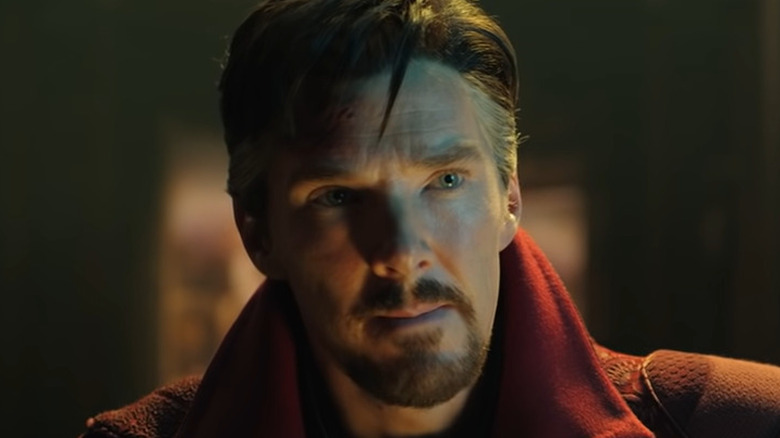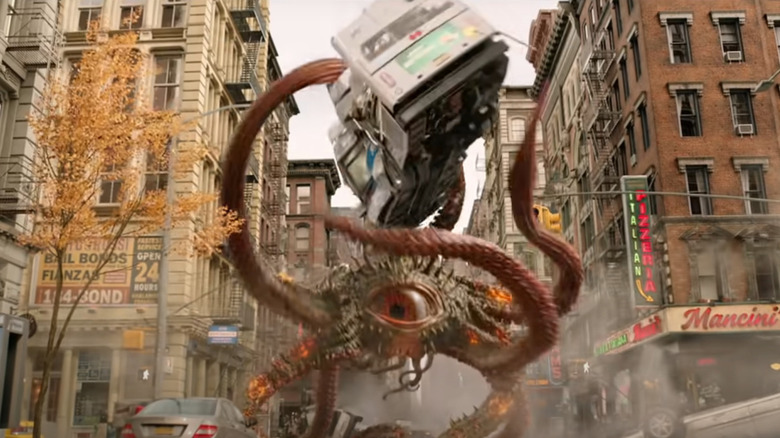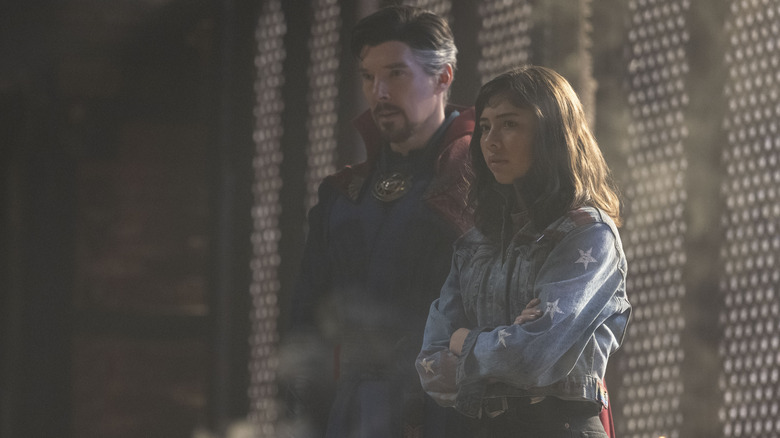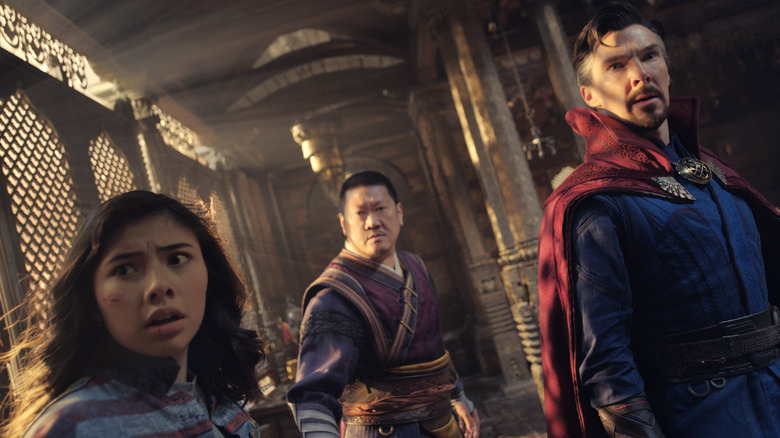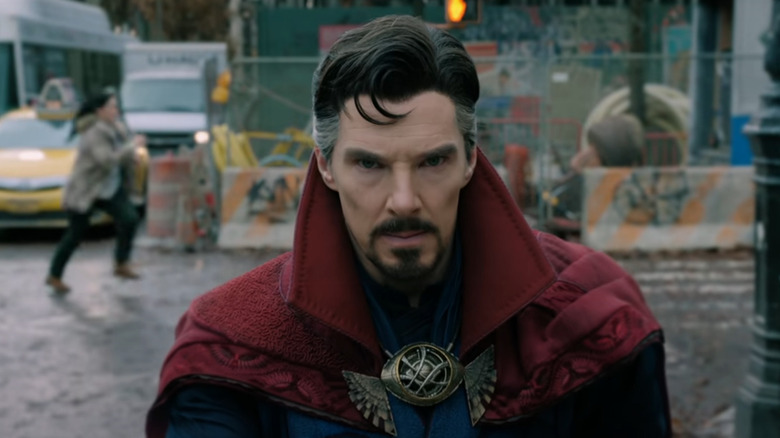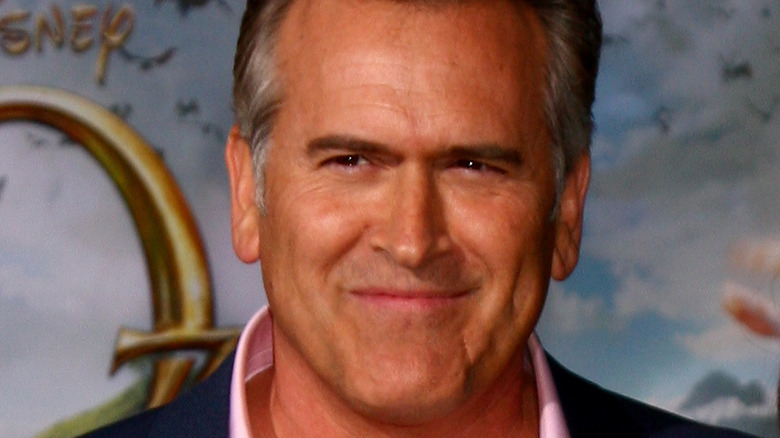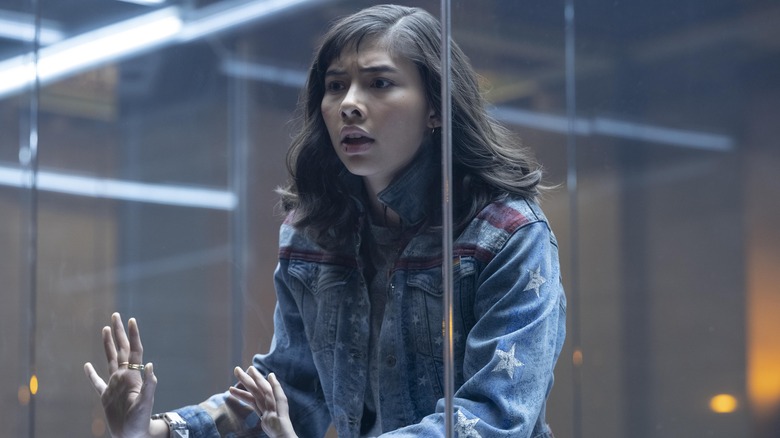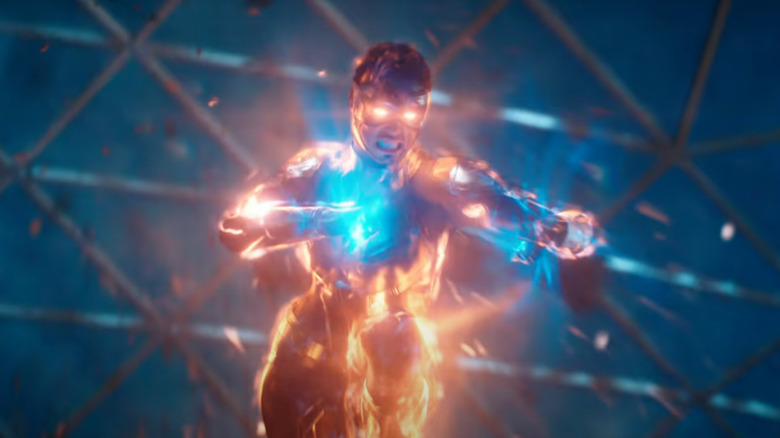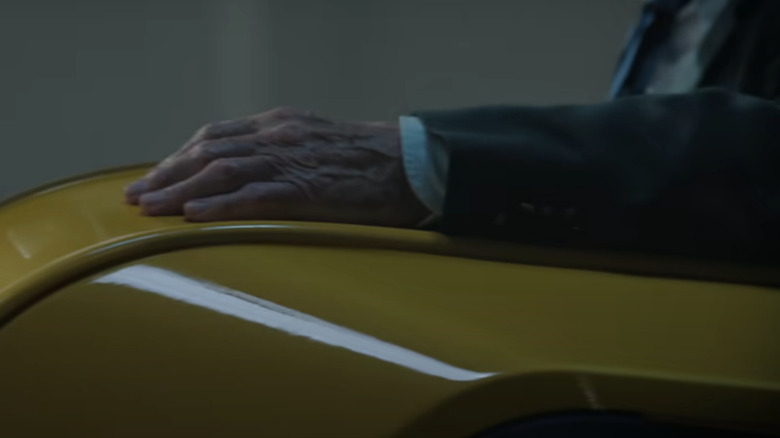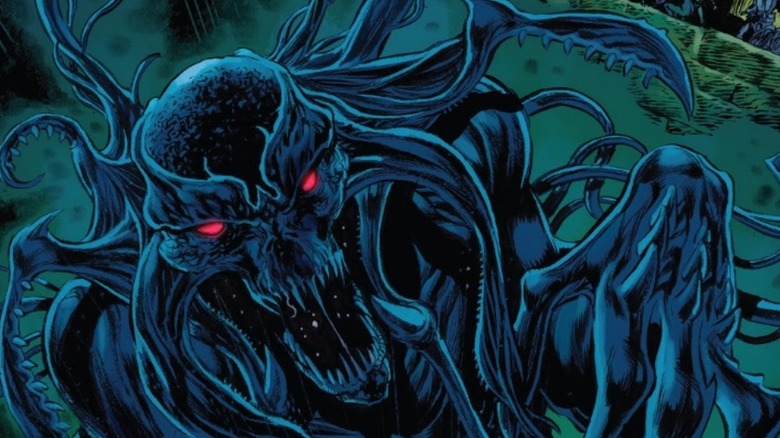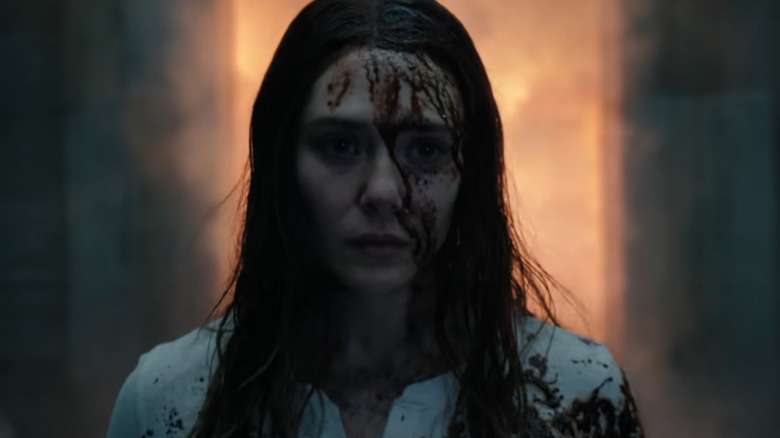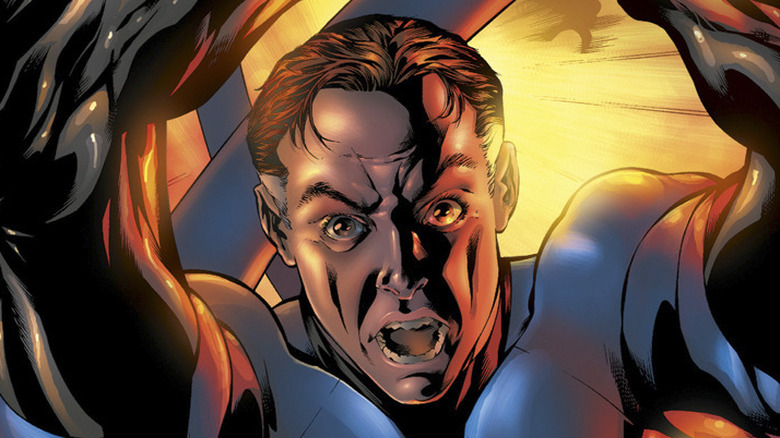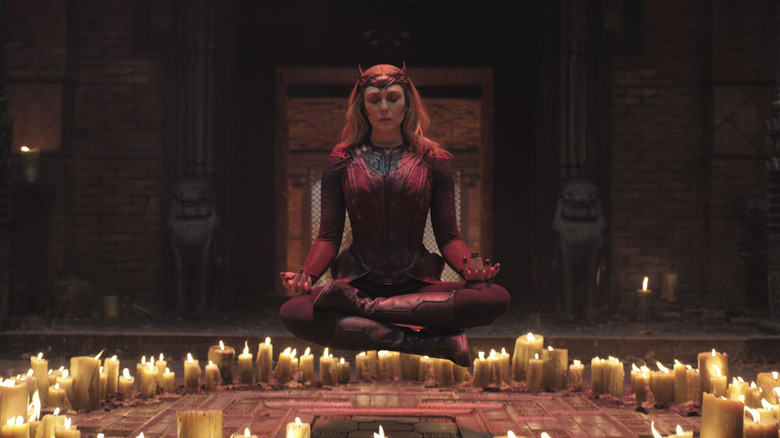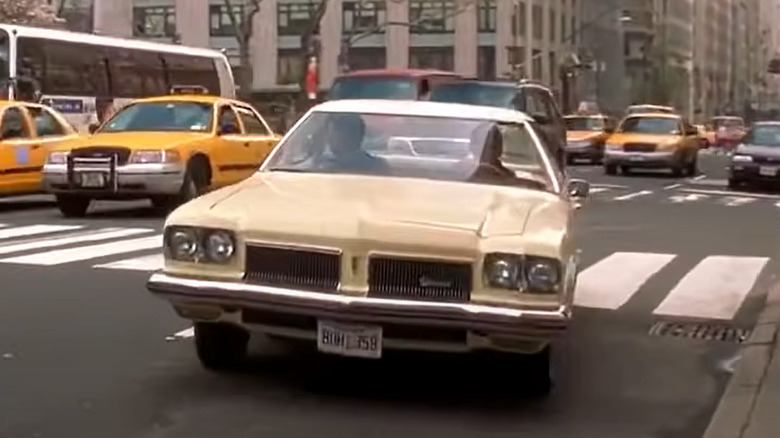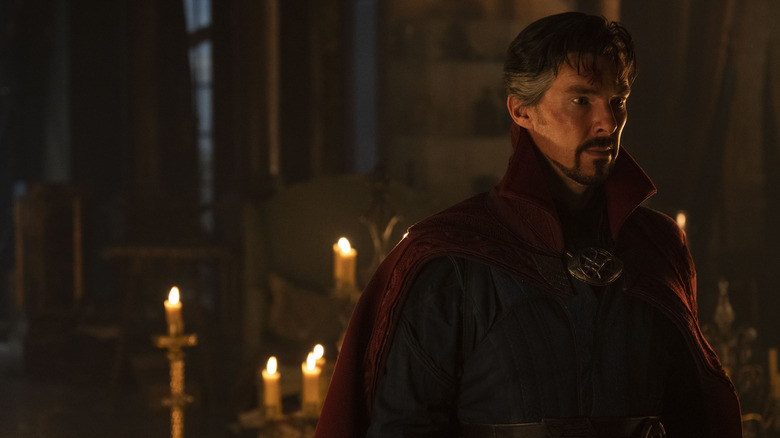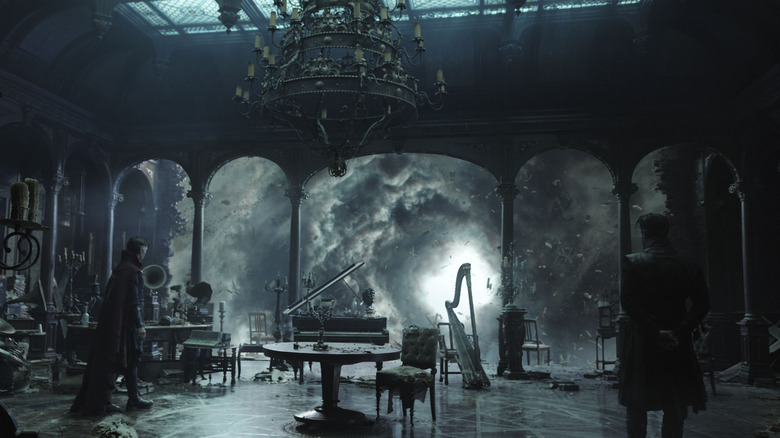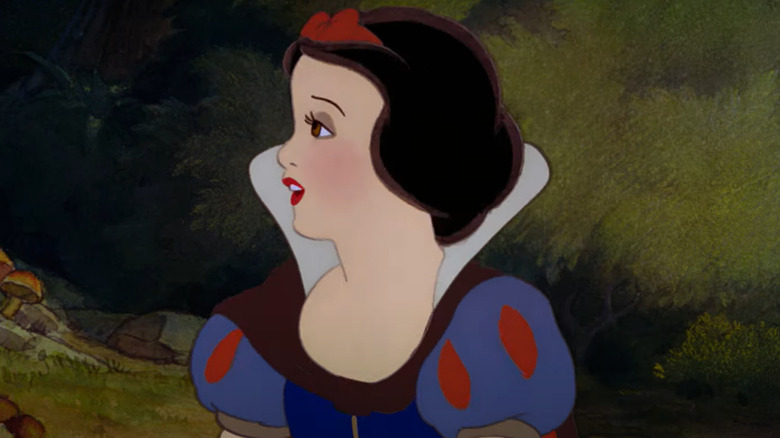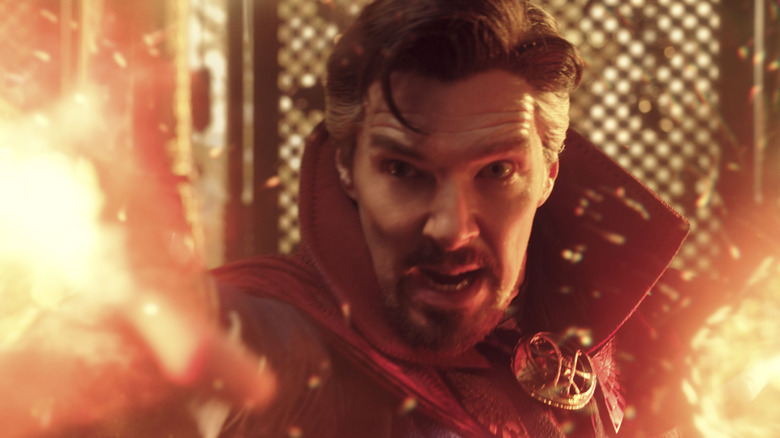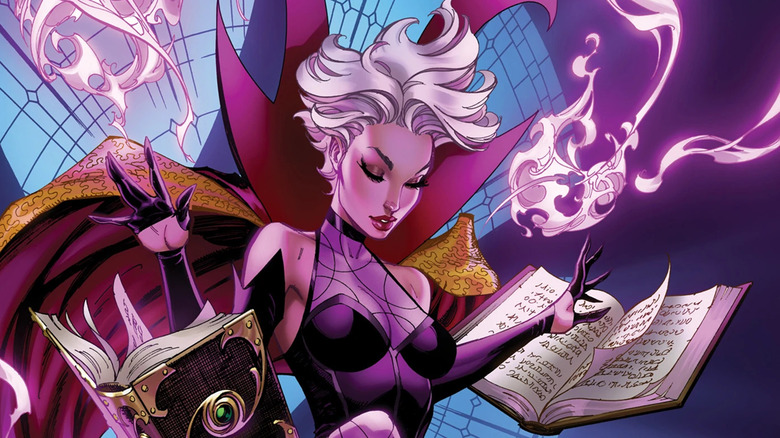Easter Eggs You Missed In Doctor Strange In The Multiverse Of Madness
"Doctor Strange in the Multiverse of Madness" is highly significant to the overall lore of the MCU, but it also features a bunch of winks and nods to other corners of Marvel's past. From old animated series and comic book storylines to live-action movies set in entirely different canons, there are a lot of references to be found within the film's two hours. And of course, the Marvel universe isn't the only franchise alluded to in "Multiverse of Madness."
In a film that deals so heavily with both magic and the multiverse, there are a ton of opportunities for subtle callbacks to other movies, characters, and plotlines. "Multiverse of Madness" fully embraces the endless potential of its titular setting. Every enemy, battle, and alternate reality is loaded with fun little touches for eagle-eyed viewers to look for, and that attention to detail is a big part of what makes the movie so successful.
From comic book beasties and narrative parallels to specific references to Sam Raimi's past films, here the Easter eggs you may have missed in "Doctor Strange in the Multiverse of Madness." Be warned, there will be major spoilers ahead.
Gargantos, or Shuma-Gorath?
When America Chavez arrives on Earth-616 in "Multiverse of Madness," she's followed by a monstrous creature under Scarlet Witch's control. The one-eyed, many-tentacled beast makes a mess of downtown New York City, but it's ultimately dispatched by the combined efforts of Doctor Strange and Sorcerer Supreme Wong. The film identifies the creature as Gargantos, which, in the comics, is the name of a sea monster that serves the subaquatic conqueror Naga.
In reality, the design of the MCU's Gargantos is much more similar to Shuma-Gorath — an eldritch being of immense power who's a major player in the comics. Shuma-Gorath is of particular significance to Doctor Strange, being a consistent foe for the sorcerer and even causing the death of the Ancient One in "Marvel Premiere" Volume 1. Unfortunately, Marvel Studios was unable to use the Shuma-Gorath name in "Multiverse of Madness" due a rights issue (per ComicBook). Still, the fusion of the Old One's visual design and Gargantos' name is a fun combo, and it makes for an exciting battle.
America Chavez's LGBTQ+ pin
America Chavez is something of a queer icon in the comics, where she's openly gay. That aspect of her identity isn't really addressed in "Doctor Strange in the Multiverse of Madness," where America spends most of her time running from monsters and trying to evade capture. However, she does sport a bit of visible LGBTQ+ pride in the form of a pride flag pin — specifically the more modern version designed by Daniel Quasar, which includes additional colors representing the transgender community and queer people of color. Marvel Studios boss Kevin Feige has confirmed that she's still canonically queer in the MCU (per Out).
In a franchise that has historically struggled with meaningful queer representation (to say the least), some fans may be fairly disappointed to see an important aspect of America's identity reduced to a simple Easter egg. A gay character's story doesn't need to just be about being gay, but it might have been nice to get a little bit more than just a pin.
The strange corners of the multiverse
After escaping from Scarlet Witch at Kamar-Taj, Doctor Strange and America Chavez fall through a portal that hits a number of different alternate universes on the way down. It's visually stunning montage that demands to be rewatched, if only because of the many little Easter eggs sprinkled throughout it.
Some of the worlds glimpsed in the portal scene are pretty explicit in their weirdness (people are paint, people are made of blocks, people are cartoons), but others may be winks and nods some different places in the Marvel comic multiverse. Among the many dimensions that Strange and America plummet through are a black and white world reminiscent of Marvel's "Noir" comics, a sci-fi cityscape reminiscent of the "2099" timeline, and a prehistoric-looking universe that could be a reference to the Savage Land (which, to be fair, is a part of Earth-616 in the comics).
There's also a very brief shot of what appears to be a looming cosmic figure — none other than the fearsome Living Tribunal.
Earth-838 and Earth-616
"Doctor Strange in the Multiverse of Madness" visits a lot of different dimensions. However, most of its time in spent in two primary realities — the main MCU timeline, and the one where the Illuminati rule. A variant of Doctor Christine Palmer designates the first of these 616, and the second one 838. She also mentions that she works for the Baxter Foundation — a foreshadowing of the Fantastic Four reveal that follows soon thereafter (the group's classic headquarters in the comics is the Baxter Building).
If you're a fan of the Marvel comics to any extent, 616 barely counts as an Easter egg. It's the primary universe of the comics canon where most of the main action takes place. With that in mind, it makes total sense that the MCU would give its own primary universe the same numerical designation, but it's still fun to hear the number actually spoken out loud.
Earth-838 isn't a designation of any real significance in the comics, but it does feature some fun little details of its own for viewers to look out for. From the fashion trends visible on the street to the kinds of food people are shown eating, there's a lot of richness and humor poured into each of the 838 scenes.
The Bruce Campbell cameo
If you're a Sam Raimi fan, chances are you're a Bruce Campbell fan too. Ever since playing Ash in the first "Evil Dead" film, he's been a favorite star among horror movie fans in particular and a prolific actor all around. Those who haven't seen "Evil Dead" may know Campbell from his costarring role as Sam Axe on "Burn Notice" or as Autolycus in "Xena: Warrior Princess." Or maybe you know him from his one of his multiple guest roles in the Tobey Maguire "Spider-Man" movies, which also happen to be directed by Sam Raimi.
Campbell and Raimi first met as kids, and they've remained close friends and collaborators ever since. The two rose to fame together with the original "Evil Dead," trilogy, and Campbell has continued to appear in small roles throughout the director's filmography. In "Doctor Strange in the Multiverse of Madness," Campbell plays a sidewalk restaurateur by the name of Pizza Poppa on Earth-838. He only appears in two scenes — an early moment after Doctor Strange and America arrive in his universe where he yells at them for stealing one of his pizza balls, and the second (and last) post-credits scene in the film, where he's shown being tormented by Strange's self-slapping spell and breaks the fourth wall. Even in that brief time, though, Campbell quickly reminds audiences why he's such a beloved talent.
America's original home
While wandering through Earth-838 with Doctor Strange, America Chavez happens upon a device that turns your most important memories into projected video clips. When she uses the machine, it shows a tragic moment from her childhood, when she accidentally opened a portal for the first time and her mothers were sucked into it. The scene isn't elaborated on much in the film, but many of the details are strikingly similar to America's comic book origin story.
In the comics, America is born in a dimension outside of the normal multiverse called the Utopian Parallel. She does tragically lose her parents in that story as well, who are both women, but it's due to an external crisis instead of her own powers. The more interesting part of the Utopian Parallel in the context of "Multiverse of Madness," however, is that's it's directly connected to godlike being called the Demiurge — also known as Wanda Maximoff's son Billy.
Under the superhero name Wiccan, Billy gradually becomes one of the most powerful characters in the entire Marvel comics universe, even matching his esteemed mother's magical abilities. His final form is that of the nigh-omnipotent Demiurge, whose power sustains the Utopian Parallel. "Doctor Strange 2" doesn't make any direct connection between America Chavez and Wiccan, but the MCU could possibly recreate that storyline down the road.
The Illuminati's origins
A big part of the story in "Doctor Strange 2" revolves around the Illuminati, a secretive group of super-people who guide the world (theoretically toward good) on Earth-838. The group is a major staple of the comics, including in famous storylines like "Planet Hulk" and "Secret Invasion." Each member of the council in "Multiverse of Madness" has some unique connection to the rest of the Marvel universe, which is what makes their role in the film so intriguing.
The first Illuminati member met in "Doctor Strange 2" is a variant of Karl Mordo (Chiwetel Ejiofor) who, while less evil than the one from Earth-616, still seems to be a bit conniving and prone to anger. Captain Carter (Hayley Atwell) will be familiar to those who watched "Marvel's What If...?" Season 1, which shows a universe in which Peggy Carter, not Steve Rogers, took the super-soldier serum. The Captain Marvel of Earth-838 is Maria Rambeau (Lashana Lynch), a close friend of 616 Captain Marvel Carol Danvers. Anson Mount's Black Bolt may seem like a newcomer to many viewers, but he first debuted in the short-lived TV series "Marvel's Inhumans" on ABC. And of course, "Multiverse of Madness" finally brings the Fantastic Four to the MCU by introducing John Krasinski's Reed Richards.
Last but certainly not least is 838's variant of Charles Xavier, played as he is in the Fox "X-Men" movies by Sir Patrick Stewart.
A retro Professor X
Of all the Illuminati members in "Doctor Strange in the Multiverse of Madness," Patrick Stewart's Professor X is arguably the most surprising addition. That's partly because the film franchise that made Stewart's version of the character famous was produced entirely by a separate studio. Since Disney's purchase of Fox, the introduction of mutants and the X-Men to the MCU has seemed inevitable, and now "Doctor Strange 2" has officially canonized them.
However, the film's Professor X isn't surprising simply because of his actor, or because of what his debut means for the future of the MCU. It's particularly interesting because everything about him mirrors his incarnation in the 1990s cartoon "X-Men: The Animated Series," right down to the massive golden chair (also featured in a number of classic comics) and the pose he strikes when using his psychic powers. The film even uses a bit of the animated series' theme music to herald Xavier's arrival.
Chthon and Mount Wundagore
When his sorcerers' meddling ends in the destruction of Earht-616's Darkhold, Wanda demands that Wong tells her everything he knows about the book and its magic. He refuses at first, but he becomes more agreeable when she starts torturing soem surviving sorcerers — one of whom, the green minotaur Rintrah, is a major player in the comics and an eventual apprentice of Doctor Strange himself. Wong reveals that the Darkhold was transcribed from ancient runes and magical knowledge carved into the mythical Mount Wundagore. When he and Wanda journey there together, they find what seems to be a temple erected in honor of the Scarlet Witch.
Wanda's Chaos Magic in the comics is directly tied to Mount Wundagore, which was the final home of the ancient Elder God turned demon Chthon before he left the human realm for a parallel dimension. Wong mentions Chthon by name in "Multiverse of Madness," albeit only briefly. In the comics, Wanda is brought to Mount Wundagore as a young child and experimented on relentlessly with Chaos Magic — a process that binds her forever to Chthon and his dark powers. The eldritch monsters Wanda finds at the mountain in "Multiverse of Madness" bow to her because they recognize the Chaos magic within her, which essentially makes her both their ruler and their kin. The exact nature of how she first obtained those powers in the MCU, however, remains unknown. Per "WandaVision," she was magical before ever being exposed to the Mind Stone.
Paying homage to horror
Sam Raimi is one of the great masters of the modern horror movie genre, so it only makes sense that "Doctor Strange in the Multiverse of Madness" pays tribute to some of the greats of the past. In particular, Scarlet Witch's bloody crusade parallels her with a number of prominent horror movie characters, each of whom relates to Wanda's arc in some way.
During her brutal assault on Kamar-Taj, Wanda adopts some truly freaky moements and mannerisms. In one shot, she crawls out of a mirror at America Chavez, but her body is all contorted and twisted up in impossible ways. For many, this moment will bring back memories of demonic possession films like "The Exorcist," which is appropriate given that Wanda's soul has been corrupted and overtaken by the dangerous magic of the Darkhold. Different moments in the Kamar-Taj sequence and some later scenes also style Wanda similarly to the infamous character Kayako Saeki from "The Grudge," the American remake of which was produced by Sam Raimi. In that film, there's a deadly cursed that's triggered by powerful negative emotions and death — two things Wanda Maximoff is all too familiar with.
Later on, after Wanda successfully dreamwalks into Universe 838, her blood-covered face and clothes and her violent behavior harken back to Stephen King's "Carrie." Just like Carrie, Wanda has fully realized her powers as the Scarlet Witch, and the results are quite grotesque.
Mr. Fantastic's family
Once in the body of her 838 counterpart, Scarlet Witch infiltrates the Illuminati headquarters and makes short work of their Ultron robots, which seem much more mild-mannered and less dangerous than the Ultron of Earth-616. The group of heroes confronts her, and Reed Richards tries to talk her down from her assault. She asks him if he has any children, and if their mother is still alive. Mr. Fantastic answers yes to both questions, and moments later Wanda literally rips him to shreds.
It's an unsettling death for one of Marvel's most respected heroes, especially given the information Reed previously revealed. Fans of the "Fantastic Four" comics will know that the mother in question is almost certainly Sue Storm, AKA the Invisible Woman. The children themselves could be Franklin and Valeria — the couple's son and daughter in the comics lore. Now that John Krasinski has officially been cast as Mr. Fantastic in the MCU, the rumors of his real-world wife Emily Blunt playing Sue Storm in the future may have some newfound credence. Only time will tell.
Scarlet Witch or Dark Phoenix?
Scarlet Witch makes short work of most of the Illuminati, but she's brought closest to defeat by the last member standing, Charles Xavier. The powerful psychic infiltrates her brain to try to stop her violent attack, but what he finds there is a bit more than he bargained for. Wanda's mindscape is a white void filled with piles of rubble — a clear callback to her traumatic, war-torn childhood. Xavier finds Wanda's original, unpolluted consciousness trapped beneath one of these piles (just as she was trapped as a child), but before he can get her loose, the Scarlet Witch persona finds him and ends his life.
The combination of Wanda's split personality, fall from hero to villain, nearly limitless power, murder of Charles Xavier, and association with the color red all make her feel very, very similar to another famous "X-Men" character: Jean Grey. The "Dark Phoenix" arc, which sees the red-haired Jean be overtaken by a dark and powerful force and lash out against her friends, is a huge piece of the "X-Men" comics lore. It's also been adapted for the big screen twice before, though neither attempt was particularly well-received (per Time). "X-Men: The Last Stand" features a scene where Jean's evil alter-ego vaporizes Xavier, and those who've seen the movie may well remember it after witnessing Wanda's own brutal killing of the professor.
Sam Raimi's Delta 88
When their plan to defeat Wanda with the Book of Vishanti (which itself is a hugely important magical artifact in the Marvel comics) goes awry, Doctor Strange and Earth-838's Christine Palmer wind up in a post-apocalyptic netherworld. The realm is the result of an incursion — a cataclysmic event that occurs when multiple realities of the multiverse come crashing together. Most of the landscape is composed of ghostly haze, crumbling buildings, and physical phenomena that would be impossible in our world.
One of these supernatural details is a floating car, and not just any floating car. Specifically, it's the 1973 Oldsmobile Delta 88 that Sam Raimi includes in practically all of his movies. The vehicle first appeared on screen as Ash's car in the first "Evil Dead," and it's also been driven by Spider-Man's Uncle Ben, among others. Like Bruce Campbell's oddball cameo, the Delta 88 is a touch that Raimi diehards will quickly recognize and should be excited to see.
Doctor Strange's sister
While trying to get back to Earth-616 and save America Chavez from the Scarlet Witch, Doctor Strange encounters a strange foe — a variant of himself who's become intensely corrupted by the Darkhold. When the two first meet, Strange 616 doesn't realize the extent of his doppelganger's villainy. In fact, it's the sinister Doctor Strange who demands proof of the other's identity, which is provided in the form of a tragic tale.
Doctor Strange reveals that he had a sister named Donna who died as a child. He says that she fell through the ice while they were playing on a frozen lake, and that he was unable to save her. Donna Strange is also present in the comics, though her fate is a little bit different. She does experience a medical emergency at the age of nine, but her brother is able to help her through it. Later, as a teenager, Donna suffers a fierce cramp while swimming and ends up drowning, meeting the same grim end as her MCU counterpart. The original "Doctor Strange" movie was meant to have a scene showing this tragic element of Stephen's past, but it was ultimately cut from the final version (per Digital Spy).
The fate of Sinister Strange
If you've seen "Marvel's What If...?" Season 1 on Disney+, you'll probably notice a lot of similarities between the evil Doctor Strange in that series and the one who features in "Multiverse of Madness." Both caused the destruction of their realities because of hubris and corrupt, selfish thinking. However, they're not the same character. "What If...?" Strange is at least remorseful by the end, whereas the sinister Strange in "Multiverse of Madness" has been fully corrupted by the Darkhold.
He even confesses to the main Doctor Strange that he's killed many of their variants by dreamwalking. "You ever have that dream where you're falling off of a tall building?" he asks with a fiendish glint in his eye. "That was probably me." In a bit of dramatic irony, the villainous sorcerer meets his end in that very same way. He gets blasted out of the window of his own tower and is impaled on a spike when he reaches the ground.
Disney classics
In two different scenes, "Multiverse of Madness" shows the idyllic home life of Wanda, Tommy, and Billy on Earth-838. And both of those times, the kids are watching some kind of Disney classic on the TV.
The first time, in the scene where Scarlet Witch first dreamwalks into her 838 counterpart, the boys are watching an old black and white Disney animated film. Viewers can make out Oswald the Lucky Rabbit — a character that Walt Disney created and lost the rights to in the late 1920s (per Collider). Oswald was effectively replaced by Mickey Mouse, who went on to become a symbol for the entire Disney company. Disney reacquired the rights to Oswald in 2005, and the character has since appeared in several Disney projects — including "Multiverse of Madness."
The second time, when Wanda is thrown back into Universe 838 by America during the film's climax, Tommy and Billy are watching "Snow White and the Seven Dwarves." That could be seen as a thematically relevant choice, as it's the scene where Wanda "wakes up" from her enchantment, just as Snow White eventually wakes up from her own.
The real Eye of Agamotto
At the very end of "Doctor Strange in the Multiverse of Madness," Stephen returns home, fixes the watch Christine once gifted him, and seems to be getting his life back on track. It isn't long before the bizarre strikes once again, however. While out for a normal walk, Doctor Strange is overcome with pain and begins convulsing on the ground. The camera then zooms in to show a third eye pop open on the character's forehead.
Because the evil Doctor Strange encountered earlier in the film also had a third eye, and because he used the Darkhold constantly, it's possible that Strange 616's third eye is tied to his own use of the Book of the Damned. However, a more likely possibility is that his ocular addition has to do with the Eye of Agamotto.
In the comics, the Eye of Agamotto has a wide range of powers that have yet to be seen in the MCU. They mostly involves foresight, truth-seeing, and other abilities connected to knowledge and vision. As such, these powers often manifest in the form of a third eye, which Doctor Strange can be seen sporting in a number of Marvel comics. Historically, Agamotto has been one of the Vishanti — three deities who aid the Sorcerer Supreme and the authors of the Book of Vishanti. Is it possible that Strange's exposure to the book unlocked the eye's true powers?
Doctor Strange and Clea
If you're not a comic book reader, the first post-credits scene of "Doctor Strange in the Multiverse of Madness" might not make a ton of sense. The scene shows a purple-clad woman played by Charlize Theron approaching Doctor Strange on the street and recruiting him to help fix an incursion that she claims he caused. When he agrees, she slashes open a ragged portal to another dimension, theoretically beginning the doctor's next adventure.
The credits themselves reveal that Theron's character is named Clea, making her an incredibly important figure in Doctor Strange's comic book arc. Clea is a powerful sorcerer who lives most of her life in the Dark Dimension, where she frequently clashes with Dormammu. She and Doctor Strange eventually strike up a romantic relationship and even get married. Her purple look, immense power, and no-nonsense attitude in Theron's iteration are all faithful to the comics. That bodes well for the next "Doctor Strange" movie, which will likely feature Clea heavily.
